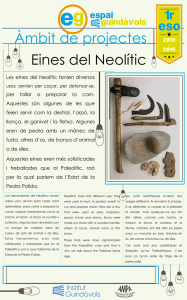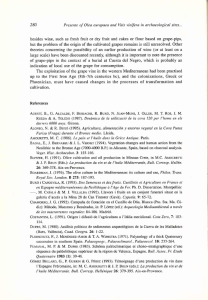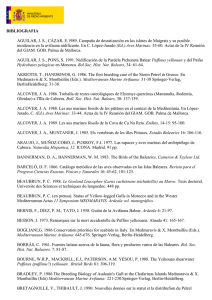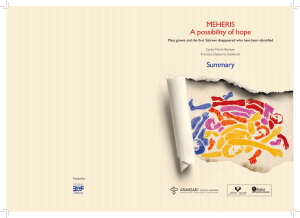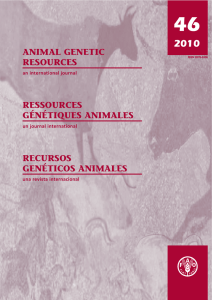WEIGHT-LENGTH RELATIONSHIPS AND CONDITION FACTOR OF
Anuncio
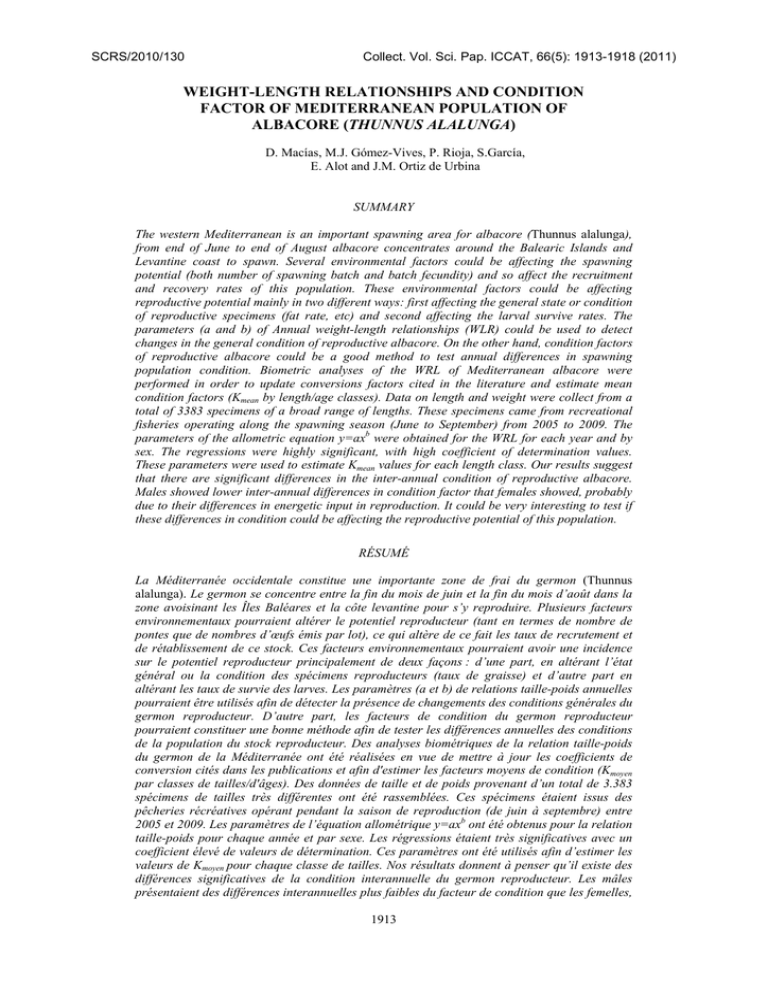
SCRS/2010/130 Collect. Vol. Sci. Pap. ICCAT, 66(5): 1913-1918 (2011) WEIGHT-LENGTH RELATIONSHIPS AND CONDITION FACTOR OF MEDITERRANEAN POPULATION OF ALBACORE (THUNNUS ALALUNGA) D. Macías, M.J. Gómez-Vives, P. Rioja, S.García, E. Alot and J.M. Ortiz de Urbina SUMMARY The western Mediterranean is an important spawning area for albacore (Thunnus alalunga), from end of June to end of August albacore concentrates around the Balearic Islands and Levantine coast to spawn. Several environmental factors could be affecting the spawning potential (both number of spawning batch and batch fecundity) and so affect the recruitment and recovery rates of this population. These environmental factors could be affecting reproductive potential mainly in two different ways: first affecting the general state or condition of reproductive specimens (fat rate, etc) and second affecting the larval survive rates. The parameters (a and b) of Annual weight-length relationships (WLR) could be used to detect changes in the general condition of reproductive albacore. On the other hand, condition factors of reproductive albacore could be a good method to test annual differences in spawning population condition. Biometric analyses of the WRL of Mediterranean albacore were performed in order to update conversions factors cited in the literature and estimate mean condition factors (Kmean by length/age classes). Data on length and weight were collect from a total of 3383 specimens of a broad range of lengths. These specimens came from recreational fisheries operating along the spawning season (June to September) from 2005 to 2009. The parameters of the allometric equation y=axb were obtained for the WRL for each year and by sex. The regressions were highly significant, with high coefficient of determination values. These parameters were used to estimate Kmean values for each length class. Our results suggest that there are significant differences in the inter-annual condition of reproductive albacore. Males showed lower inter-annual differences in condition factor that females showed, probably due to their differences in energetic input in reproduction. It could be very interesting to test if these differences in condition could be affecting the reproductive potential of this population. RÉSUMÉ La Méditerranée occidentale constitue une importante zone de frai du germon (Thunnus alalunga). Le germon se concentre entre la fin du mois de juin et la fin du mois d’août dans la zone avoisinant les Îles Baléares et la côte levantine pour s’y reproduire. Plusieurs facteurs environnementaux pourraient altérer le potentiel reproducteur (tant en termes de nombre de pontes que de nombres d’œufs émis par lot), ce qui altère de ce fait les taux de recrutement et de rétablissement de ce stock. Ces facteurs environnementaux pourraient avoir une incidence sur le potentiel reproducteur principalement de deux façons : d’une part, en altérant l’état général ou la condition des spécimens reproducteurs (taux de graisse) et d’autre part en altérant les taux de survie des larves. Les paramètres (a et b) de relations taille-poids annuelles pourraient être utilisés afin de détecter la présence de changements des conditions générales du germon reproducteur. D’autre part, les facteurs de condition du germon reproducteur pourraient constituer une bonne méthode afin de tester les différences annuelles des conditions de la population du stock reproducteur. Des analyses biométriques de la relation taille-poids du germon de la Méditerranée ont été réalisées en vue de mettre à jour les coefficients de conversion cités dans les publications et afin d'estimer les facteurs moyens de condition (Kmoyen par classes de tailles/d'âges). Des données de taille et de poids provenant d’un total de 3.383 spécimens de tailles très différentes ont été rassemblées. Ces spécimens étaient issus des pêcheries récréatives opérant pendant la saison de reproduction (de juin à septembre) entre 2005 et 2009. Les paramètres de l’équation allométrique y=axb ont été obtenus pour la relation taille-poids pour chaque année et par sexe. Les régressions étaient très significatives avec un coefficient élevé de valeurs de détermination. Ces paramètres ont été utilisés afin d’estimer les valeurs de Kmoyen pour chaque classe de tailles. Nos résultats donnent à penser qu’il existe des différences significatives de la condition interannuelle du germon reproducteur. Les mâles présentaient des différences interannuelles plus faibles du facteur de condition que les femelles, 1913 ce qui est probablement dû à leur manière différente de stocker les réserves énergétiques nécessaires à la reproduction. Il pourrait être très intéressant de vérifier si ces différences de condition peuvent avoir une incidence sur le potentiel reproducteur de cette population. RESUMEN El Mediterráneo occidental es una importante zona de reproducción para el atún blanco (Thunnus alalunga), desde finales de junio hasta finales de agosto, el atún blanco se concentra en torno a las Islas baleares y la costa levantina para reproducirse. Varios factores medioambientales podrían estar afectando al potencial de reproducción (tanto el número puestas de reproducción como a la fecundidad por lote de puesta) y por tanto, al reclutamiento y a las tasas de recuperación de esta población. Estos factores medioambientales podrían afectar al potencial de reproducción sobre todo de dos maneras diferentes: en primer lugar, afectando al estado o condición general de los reproductores (tasa de grasa, etc.) y, en segundo lugar, afectando a las tasas de supervivencia de las larvas. Los parámetros (a y b) de las relaciones talla-peso (WLR) anuales podrían utilizarse para detectar cambios en la condición general del atún blanco reproductor. Por otro lado, los factores de condición del atún blanco reproductor podrían ser un buen método para comprobar las diferencias anuales en la condición de la población reproductora. Se desarrollaron análisis biométricos de la WRL del atún blanco del Mediterráneo para actualizar los factores de conversión citados en la bibliografía y estimar los factores de condición media (Kmean por clases de talla/edad). Se recopilaron datos de talla y peso de un total de 3.383 ejemplares de una amplia gama de tallas. Estos ejemplares procedían de las pesquerías de recreo que operaron durante la temporada de reproducción (junio a septiembre) desde 2005 hasta 2009. Se obtuvieron los parámetros de la ecuación alométrica y=axb para la WRL para cada año y por sexos. Las regresiones fueron bastante significativas con un alto coeficiente de valores de determinación. Estos parámetros se utilizaron para estimar valores de Kmean para cada clase de edad. Nuestros resultados sugieren que hubo diferencias importantes en la condición interanual del atún blanco reproductivo. Los machos presentaban menos diferencias interanuales en el factor de condición que las hembras, probablemente debido al diferente modo de almacenar las reservas energéticas necesarias para la reproducción. Sería interesante comprobar si estas diferencias en la condición podrían estar afectando al potencial reproductivo de esta población. KEYWORDS Albacore, condition factor, weight-length relationships, western Mediterranean Sea 1. Introduction The western Mediterranean is an important spawning area for albacore (Thunnus alalunga), from end of June to end of August albacore concentrate around Balearic Islands and East Spanish coast to spawn (Alemany et al., 2010). Several environmental factors could be affecting the spawning potential (both number of spawning batch and batch fecundity) and so affect the recruitment and recovery rates of this population. These environmental factors could be affecting the reproductive potential in two different ways: first modifying the general state or condition of reproductive specimens (fat rate, etc) and second, affecting the larval surviving rates. The parameters (a, and b) of annual weight-length relationships (WLR) could be used to detect changes in the general condition of reproductive albacore. On the other hand, to use “Corrected Fulton´s condition factors” (FCC) could be a good method to test annual differences in condition of spawning population of albacore. In the framework of the Marine Recreational Fisheries, a series of competitions take place in the Spanish Mediterranean. Every year a similar number of recreational boats, with the same fishing gear and technical capacity, participate in these events. They take place in the spawning season and spawning ground of albacore. 1914 The aim of this study is to analyse the data on weight and length of reproductive albacore collected in these recreational fisheries and carry out biometric analysis of the WLR of Mediterranean albacore. These biometric analyses were performed to update conversions factors cited in the literature and also to test possible inter-annual variations in WLR parameters and FCC of this albacore population. 2. Materials and methods 2.1 Fishery description Observations were made from 2005 to 2009, in ports of the Balearic Islands (S´Estanyol and Soller), East Spanish coast (Xávea, Denia and Torrevieja) and Catalonian coast (Port Balís). Fishing was carried out by pelagic trolling with seven fishing lines baited with lures (artificial bait). The duration of recreational contests was two days. The fishing grounds of these contests were 60 nautical miles from base harbour. 2.2 Data collection Catch and effort data for the above described fishery were collected by the Recreational Fisheries Monitoring Program (MRF) of Spanish Oceanographic Institute (IEO), planned according to ICCAT recommendations. Data were collected by scientific samplers during landing. Each record includes the following information: catch both in number of fish and weight, and length. The specimens were sexed and gonads were weighed. In addition, number of participating anglers, fishing hours. Data on length and weight were collect from a total of 3383 specimens of a broad range of lengths. These specimens came from recreational fisheries operating along the spawning season (June to September) from 2004 to 2009. 2.3 Data analysis We used a non parametric bootstrap through an R routine. This routine calculates the W-L relationships using non lineal estimation and fit it by minimum squares (Gauss-Newton algorithm). CV for WLR parameters (a, and b) were estimated through non parametric bootstraps. Moreover, we calculated the Condition index of Clark (1928) in order to test possible differences between sexes, and years. Clark (1928) derived Kmean from WRL parameters (a, and b). Kmean represents the mean condition factor for a given length class (Froese, 2006). mean 100a Lb 3 We tested the normality of the data using a Kolmogorov-Smirnov test. Due to our Kmean data do not showed a normal distribution, we use non parametric alternatives to contrast our hypothesis. When we compare two independent cases the U Mann-Witney contrast was used; but when we compare more than two independent cases a Kruskal-Wallis contrast was applied. 3. Results and discussion A total of 400 trips were recorded during the monitoring period. Average number of trips per year amounted to 66.5. 1915 Table 1 shows the parameters a, and b of the WLR for albacore female. The same information for albacore male can be found in Table 2. Parameters for sex combined albacore are shown in Table 3. Our data showed significant differences between male and female condition factors (see U Mann-Witney contrast in Table 4). The contrast of H Krustal-Wallis for Kmean showed significant differences between years (Table 5). The year with the lowest condition was 2005 (1.908) and the year with the highest condition was 2009 (2.02). Males showed lower inter-annual differences in condition factor (Figure 1) than females showed (Figure 2), probably due to their differences in energetic input in reproduction. It could be very interesting to test at which level these differences in condition could be affecting the reproductive potential of this population. 4. Acknowledgements We are grateful to the skippers and crews of recreational fisheries who worked voluntarily with the Recreational Fisheries Monitoring Program (MRF), to our colleagues of the Large Pelagic Fisheries department of Málaga for their assistance with the data collection and literature. 5. References Alemany, F., Quintanilla, L., Velez-Belchí, P., García, A., Cortés, D., Rodríguez, J.M., Fernández de Puelles, M.L., González-Pola, C. and López-Jurado, J.L. 2010, Characterization of the spawning habitat of Atlantic bluefin tuna and related species in the Balearic Sea (western Mediterranean). Progress in Oceanography 86: 21-38. Clark, F.N. 1928, The weight-length relationship of the California sardine (Sardinella caerulea) at San Pedro. Division of Fish and Game, Fish Bull. No. 12, 59 pp. Froese, R. 1928, Cube law, condition factor and weight-length relationships: history, meta-analysis and recommendations. 2006. J. Appl. Ichthyl. No. 22, 241-253. Table 1. Parameter of WLR for Mediterranean albacore female, their respective CV and average condition factor (Kmean) by year studied. Female a b cva cvb Kmean Total period 2005 2006 2007 2008 2009 0.01167 3.118 0.531 0.03 1.95 0.0098 3.15 0.362 0.026 1.89 0.01572 3.05518 0.486 0.029 2.00 0.05466 2.752 0.359 0.03 1.85 0.0073 3.224 2.273 0.06 1.94 0.0264 2.931 0.621 0.033 1.95 Table 2. Parameter of WLR for Mediterranean albacore male, their respective CV and average condition factor (Kmean) by year studied. Male Total period 2005 2006 2007 2008 2009 a b cva cvb Kmean 0.03586 2.851 0.143 0.011 1.87 0.02 2.98 0.346 0.027 1.83 0.01587 3.04 0.153 0.012 1.93 0.0426 2.81 0.286 0.023 1.86 0.0458 2.794 0.246 0.021 1.80 0.092 2.638 2.603 0.078 1.90 1916 Table 3. Parameter of WLR for Mediterranean albacore (sex combined) and their respective CV. Sex combined 2005 2006 2007 2008 2009 a b CVa CVb 0.021 2.98 0.276 0.021 0.019 3.01 0.19 0.015 0.044 2.8 0.202 0.017 0.028 2.908 0.46 0.034 0.07 2.7 1.83 0.06 Table 4. U Mann-Witney contrast for K (N= 1004) by sex. Parameter U P μ Male μ Female K 95538.5 4.11*10-11 1.936 1.987 Table 5. H Kruskal-Wallis contrast for K, by years. Parameter H GL P K 83.79 4 2.737*10-17 1917 Kmean (ALB Male) 2.5 2 Kmean 2005 1.5 2006 2007 2008 1 2009 0.5 10 2 99 96 93 90 87 84 81 78 75 72 69 66 63 60 57 0 Lenght class Figure 1. Kmean of albacore male by length class. Differences between years studied are lower in intermediate length classes. Kmean (ALB female) 2.1 2 1.9 2005 Km 2006 1.8 2007 2008 2009 1.7 1.6 10 2 99 96 93 90 87 84 81 78 75 72 69 66 63 60 57 1.5 Length Class Figure 2. Kmean of albacore female by length class. Differences between years are highest in female that those showed by the males at the same length classes. 1918
